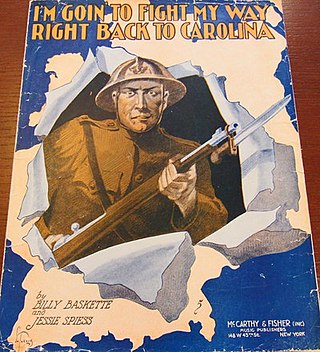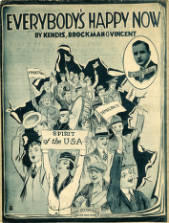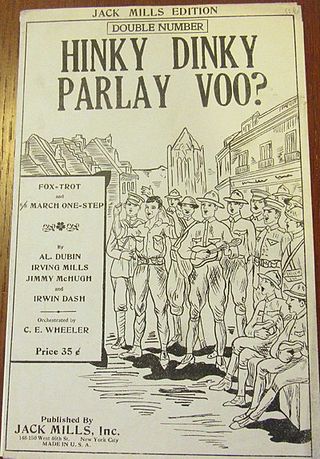Related Research Articles
Fred Fisher was a German-born American songwriter and Tin Pan Alley music publisher.

"K-K-K-Katy" is a World War I-era song written by Canadian-American composer Geoffrey O'Hara in 1917 and published in 1918. The sheet music advertised it as "The Sensational Stammering Song Success Sung by the Soldiers and Sailors", as well as "The Sensational New Stammering Song" The song was first played at a garden party fund-raiser for the Red Cross in Collins Bay on Lake Ontario. O'Hara was from Chatham, Ontario, and taught music at several universities.
The music of World War I is the music which was composed during the war or which is associated with the war.

"I'm Goin' To Fight My Way Right Back to Carolina" is a World War I era song written and composed by Billy Baskette and Jessie Spiess. The song was published in 1918 by McCarthy & Fisher, Inc. of New York City. The sheet music cover was designed by Andre C. De Takacs. It features an armed soldier tearing through the cover. The song was written for both voice and piano.

"Allegiance: Patriotic Song" is a World War I song first copyrighted on March 14, 1918.

Everybody's Happy Now is a World War I song written by James Kendis, James Brockman, and Nat Vincent in 1918. It was published by Kendis-Brockman Music Co. and written for voice and piano.

General Pershing: is a march composed in 1918 by Carl D. Vandersloot and published by Vandersloot Music Publishing Company.

Good Luck to Our Boys in Tan is a song written in 1919 by E.S.S. Huntington and published by Eva Rendall Richardson.

Some Lonesome Night is a song by George W. Meyer with lyrics by Grant Clarke and George Whiting. It was published in 1918 by Leo Feist Inc.

"Hinky Dinky Parlay Voo?" is a song composed by Al Dubin, Irving Mills, Jimmy McHugh and Irwin Dash in 1924 and published by Jack Mills, Inc. It is a sequel to the popular World War I song, "Mademoiselle from Armentières," having the same refrain.
The Home Guard: School March for Piano is a song from 1910 written by M. Greenwald and published by Will Wood.

"Oh! Frenchy" is a World War I song written by Sam Ehrlich and composed by Con Conrad. It was published in New York, New York by Broadway Music corporation in 1918. The song was in the top 20 charts from September 1918 to March 1919 and was number 2 in October, December, and February. The sheet music cover features a soldier pictured in uniform with a woman in his heart.
"Lafayette " is a World War I song written and composed by Mary Earl, which was a pseudonym of Robert A. King. It was published in New York, New York by Shapiro, Bernstein, & Co. in 1918. The sheet music cover, illustrated by Albert Barbelle, depicts soldiers marching with fixed bayonets below a statue of Lafayette in silhouette.

Don't Cry Frenchy, Don't Cry is a 1919 song written during World War I. The lyrics were written by Sam M. Lewis and Joe Young, and the music was written by Walter Donaldson.The song was published by Waterson, Berlin & Snyder Company in New York City.

Johnny's in Town is a World War I song written by Jack Yellen and composed by George W. Meyer & Abe Olman. This song was published in 1919 by Leo. Feist, Inc., in New York, NY. The sheet music cover, illustrated by Rosenbaum Studios, depicts a cartoon soldier winking with women in the background.
"Give a Little Credit to the Navy" is a World War I song written by Buddy DeSylva & Gus Kahn and composed by Albert Gumble. This song was published in 1918 by Jerome H. Remick & Co., in Detroit, MI.
"America! My Home-Land" is a World War I song written by Henry Treleaven and composed by Richard Blaine. This song was published in 1917 by Boosey & Co. in New York, NY.
While You're Over There in No Man's Land, I'm Over Here in Lonesome Land is a World War I song written by Jessie Spiess and composed by Jack Stanley. The song was first published in 1918 by Will Rossiter in Chicago, Il. The sheet music cover, illustrated by Starmer, features a woman knitting with a battle scene above.

Let's All Be Americans Now is a World War I song written and composed by Irving Berlin, Edgar Leslie, and George W. Meyer. The song was first published in 1917 by Waterson, Berlin & Snyder Co., in New York, NY.The sheet music cover depicts a soldier with his rifle and silhouetted marching soldiers in the background. A popular recording in 1917 was made by the American Quartet.
Mary F. Carty was an American musician, songwriter and music arranger.
References
- ↑ "Oh, Charlie is my darling". Pritzker Military Museum & Library. Retrieved 14 June 2016.
Bibliography
- Crew, Danny O. “Presidential Sheet Music: An Illustrated Catalogue of Published Music Associated with the American Presidency and Those Who Sought the Office”. Jefferson, North Carolina: McFarland, 2001. ISBN 0786409282 OCLC 45313670
- Jasen, David A. Tin Pan Alley: The Composers, the Songs, the Performers, and Their Times : the Golden Age of American Popular Music from 1886 to 1956. New York: D.I. Fine, 1988. ISBN 1556110995. OCLC 18135644
- Parker, Bernard S. “World War I Sheet Music: 9,670 Patriotic Songs Published in the United States, 1914–1920, with More Than 600 Covers Illustrated. Jefferson, N.C.: McFarland, 2007. ISBN 9780786424931 OCLC 71790113